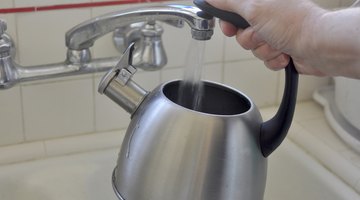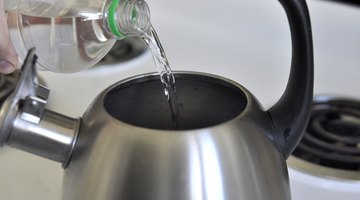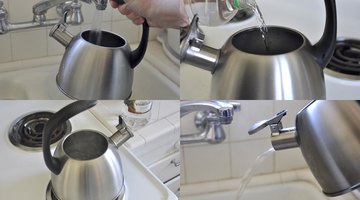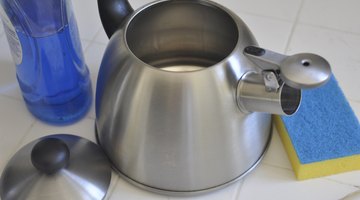How to Remove Limescale From a Kettle
Calcium carbonate is a natural compound that dissolves easily in water and, thus, often occurs in tap water. When you boil water containing calcium carbonate in a tea kettle, it will precipitate out of the water and adhere to the bottom and sides of the kettle as limescale. It isn’t dangerous, but it is unsightly.

It can flake off the inside of the kettle and end up in your coffee or tea, and if it builds up too heavily, limescale could eventually plug up the spout of the kettle. However, because calcium carbonate dissolves easily in acid, releasing carbon dioxide, you don’t need a highly corrosive acid to get rid of limescale—white household vinegar will do the trick. It's cheap, eco-friendly and easily found at your local grocery.
Things You Will Need
- 1 quart of white vinegar
- Mild dishwashing soap
- Scrubber sponge
Tip
You can clean your tea kettle every week or so using this vinegar solution without damaging it. You can use the same water/vinegar solution to remove limescale from faucets and showerheads. Other vinegars, such as cider vinegar, work equally well but usually are more expensive than white vinegar.
-
Fill your tea kettle two-thirds full with cool tap water.
-
Add enough white vinegar to fill the kettle to capacity. The ratio of white vinegar to water in the kettle should be about 1 to 2.
-
Bring the water in the kettle to a boil and let it continue to boil vigorously for 10 minutes.
-
Turn the kettle off and let it cool down a bit. When it has cooled slightly, pour the about half the contents of the kettle down the drain and take the lid off. Wait until the kettle is cool enough to handle; look inside to see if the limescale has come off the inside of the kettle. You may see flakes of limescale in the water--that's okay, as long as the limescale coating the inside has dissolved.
-
If a significant amount of limescale remains on the sides of the kettle, pour out the remaining water and repeat Steps 1 through 4. If the limescale is really stubborn, repeat Steps 1 through 3 and leave the kettle overnight with the solution in it.
-
If the sides and bottom of the kettle are relatively clean, pour out the remaining water and scrub the kettle with warm water and mild dishwashing soap on a scrubber sponge. Rinse it out thoroughly and dry it well.






The Drip Cap
- Calcium carbonate is a natural compound that dissolves easily in water and, thus, often occurs in tap water.
- Turn the kettle off and let it cool down a bit.
- You may see flakes of limescale in the water--that's okay, as long as the limescale coating the inside has dissolved.
- If the limescale is really stubborn, repeat Steps 1 through 3 and leave the kettle overnight with the solution in it.
References
Photo Credits
- Scott Miller/Demand Media
- Scott Miller/Demand Media
- Scott Miller/Demand Media
- Scott Miller/Demand Media
- Scott Miller/Demand Media
- Scott Miller/Demand Media
- Scott Miller/Demand Media
- Scott Miller/Demand Media
More Articles



